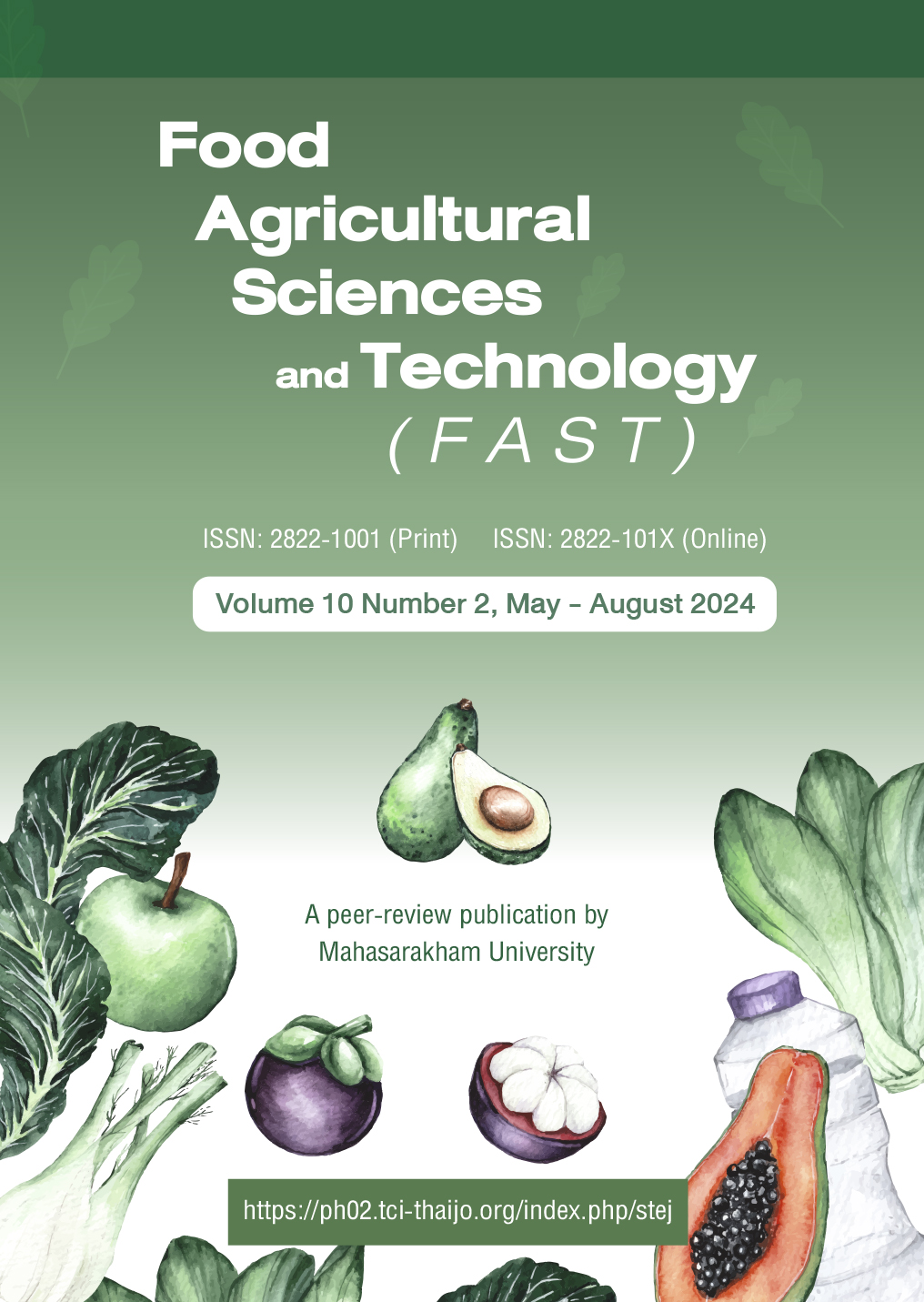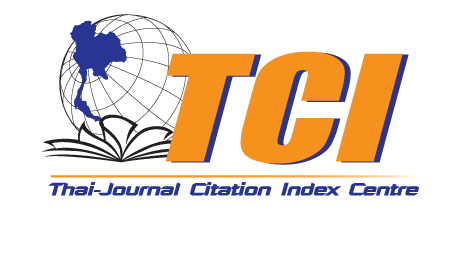Effects of adding crude glycerin in concentrate and castration on fattening performance and production return from raising Anglo-Nubian crossbred goats
Keywords:
crude glycerin in concentrate diet, castration, fattening performance, 50% Anglo-Nubian goatAbstract
Effects of adding crude glycerin in concentrate diet and castration on feed intake, growth performance, carcass characteristics, and production return of fattening 50% Anglo-Nubian x 50% Thai native goats were determined. Twenty male goats aged 12-13 months with 25.16±1.99 kg initial live weight were allotted into 2 x 2 factorial arrangement in CRD in which factor A was the type of concentrate diet (diet with no crude glycerin (CG) addition and diet with 10% of CG), and factor B was castration (intact and castrated males). Atratum (Paspalum atratum) grass was fed ad libitum, while 2% of concentrate diet was provided daily for 90 days. From the study, goats received diet with 10% CG addition had higher dry matter intake (DMI) and average daily gain (ADG) than those received a control diet (P<0.05). Castrated group had higher DMI and ADG than the non-castrated group (P<0.05). Higher slaughter weight and chilled carcass weight were observed in goats received concentrate plus 10% CG or castration while the carcasses had a higher fat percentage than the control group. Fattening goats with diet plus 10% CG and castration showed the highest economic return, but fattening goats with diet plus 10% CG could be another option. This was due to not only the high economic return was noted, but it also reduced suffering of castration.
References
Abdullah, A.Y. & Musallam, H.S. (2007). Effect of different levels of energy on carcass composition and meat quality of male black goat kids. Livestock Science, 107, 70-80.
Al-Jalil, Z.F. & Al-Wahab, R.M. (1985). Comparative study on the effect of castration on fattening and carcass tracts in Awassi, Hamdani and Arabi lambs. World Review of Animal Production, 21, 25-32.
Allan, C. J. & Holst, P. J., (1989). Comparison of growth and dressing percent between intact male, castrated male and female kids of Australian bush goats. Small Ruminant Research, 2, 63-68.
AOAC. (1990). Official methods of analysis (15th ed.). Association Official Analytical Chemists.
Barton, L., Bures, D., Homolka, P., Jancik, F., Marounek, M., & Rehak, D. (2013). Effects of long-term feeding of crude glycerine on performance, carcass traits, meat quality, and blood and rumen metabolites of finishing bulls. Livestock Science, 155, 53-59.
Cerrate, S., Yan, F., Wang, Z., Cotto, C., Sacaki, P., & Waldroup, P.W. (2006). Evaluation of glycerine from biodiesel production as feed ingredient for broiler. International Journal of Poultry Science, 5, 1001-1007.
Chacón, E, Macedo F, Velázquez F, Paiva, S.R., Pineda, E., & McManus, C. (2011). Morphological measurements and body indices for Cuban Creole goats and their crossbreds. Revista Brasileira de Zootecnia, 40, 1671-1679.
Chanjula, P., Pakdeechanuan, P., & Wattanasit, S. (2015). Effects of feeding crude glycerin on feedlot performance and carcass characteristics in finishing goats. Small Ruminant Research, 123, 95-102.
Chanjula, P. & Cherdthong, A. 2018. Effects of crude glycerin from waste vegetable oil in diets on performance and carcass characteristics fir feedlot goats. Asian-Australasian Journal of Animal Sciences, 31(4), 514-521.
Dasari, M. (2007). Crude Glycerol Potential Described. Feedstuffs, 79(43), 1-3. Devendra, C. & Burn, M. (1983). Goat production in the tropics (183 pp.). Commonwealth Agricultural Bureaux.
Detweiler, G., Gipson, T., Merkel, R.C., Goetsch, A., & Sahlu, T. (2008). Body Condition Scores in Goats. Proceedings of the 23rd Annual Goat Field Day (pp. 127-133). Langston University.
Goering, H. K. & Van Soest, P.J. (1975). Forage fiber analysis: agricultural handbook no.379. Agricultural Research USDA. Kearl, LC. (1982). Nutrient requirements of ruminants in developing countries. Utah State University.
Lammer, P. J., Kerr, B.J., Honeyman, M.S., Dozier, W.A., Weber, T.E., Kidd, T.E., & Bregendahl, K. (2008). Nitrogen corrected apparent metabolism energy value of crude glycerol for layer hens. Poultry Science, 87, 104-107.
Madruga, M.S., Arruda, S.G.B., & Nascimento, J.A. (2024). Castration and slaughter age effects on nutritive value of the “mestiço” goat meat. Meat Science, 52(2), 119-125. https://doi.org/10.1016/S0309- 1740(98)00156-9
Mahgoub, O., Kadim, I.T., Al-Sagry, N.M., & Al-Busaidi, R.M. (2004). Effects of body weight and sex on carcass tissue distribution in goats. Meat Science, 67, 577-585.
Marques, C.A.T., de Medeiros, A.N., Costa, R.G., de Carvalho, F.F.R., de Araújo, M.J., & da C. Torreão, F.F.R. (2014). Performance and carcass traits of Moxotó growing goats supplemented on native pasture under semiarid conditions. Revista Brasileira de Zootecnia, 43, 151-159.
Mach, N., Bach, A., & Devant, M. (2009). Effects of crude glycerin supplementation on performance and meat quality of Holstein bulls fed high-concentrate diets. Journal of Animal Science, 87, 632-638.
Marquette, G. A., Ronan, S. & Earley, B. (2023). Review: castration - animal welfare considerations. Journal of Applied Animal Research, 51(1), 703-718. https://DOI: 10.1080/09712119.2023.2273270.
Mudalal, M.O., Bushara, I., Mekki, D.M., & Babiker, S.A. (2014). Effect of nutrition and castration on carcass measurements, wholesale cuts and carcass composition of male desert goats. Global Journal of Animal Scientific Research, 2, 97-101.
Muhikambele, V.R.M., Mtenga, L.A., Owen, E., & Kifaro, G.C. (1996). Effect of castration and diet on performance and feed utilisation in Saanen goats. Proceedings of the 3rd Biennial Conference of the African Small Ruminant Research Network. International Livestock Research Institute Kenya.
SAS Institute Inc. (1997). SAS/STAT user’s guide version 6.12. cary. Institute Inc.
Solaiman, S, Kerth, C., Willian, K., & Min, B. (2008). Growth performance, carcass characteristics and meat quality of Boer-cross wether and buck goats grazing Marshall ryegrass. Asian-Australasian Journal of Animal Sciences, 24(3), 351-357.
TAS. (2007). Halal food. TAS 8400- 2007. Ministry of Agriculture and Cooperatives, Thailand.
TAS. (2013). Good manufacturing practices for goat and sheep abattoir. National Bureau of Agricultural Commodity and Food Standard, Ministry of Agriculture and Cooperatives, Thailand.
Thompson, J.C. & He, B.B. (2006). Characterization of crude glycerol from biodiesel production from multiple feedstock. Applied Engineering in Agriculture, 22, 261-265.
Van Keulen, J. & Yong, B.A. (1977). Evaluation of acid-insoluble ash as a natural marker in ruminant digestibility studies. Animal Science, 44, 282-287.
Van Soest, P.J., Robertson, J.B., & Lewis, B.A. (1991). Methods for dietary fiber, neutral detergent fiber and non starch polysaccharides in relation to animal nutrition. Journal of Dairy Science, 74, 3582-3597.
Wilbert, C.A., Pratesb, E.R., Barcellosc, J.O.J., & Auser, J.S. (2013). Crude glycerin as an alternative energy feedstuff for dairy cows. Journal of Animal Science, 183, 116-123.
Zamiri, M.J., Eilamib, B., & Kianzadc, M.R. (2012). Effects of castration and fattening period on growth performance and carcass characteristics in Iranian goats. Small Ruminant Research, 104, 55-61.
Downloads
Published
How to Cite
Issue
Section
License
Copyright (c) 2024 Food Agricultural Sciences and Technology

This work is licensed under a Creative Commons Attribution-NoDerivatives 4.0 International License.






